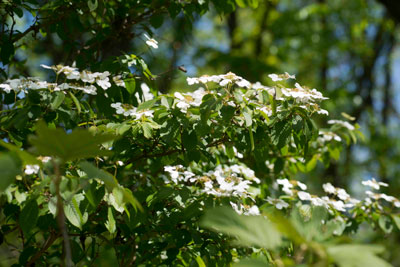Plant of the Week – April 26, 2018: Doublefile Viburnum
I grew up in Texas – College Station, to be exact. I transferred from A&M to Ohio State as a junior, and for some reason, OSU gave me credit for my plant materials courses. That let me graduate a year earlier, but it also meant that I was dumb as a buckeye stump when it came to Midwest woody plants.
However, I learned as many as I could as quickly as I could, and one of the groups that stood out most in my mind were the lovely viburnums.
We moved to Texas (where I thought I knew everything because it was where I’d cut my teeth in horticulture) so I could work for the Extension Service, and almost immediately I started importing Ohio woody plants to try in our landscape.

Clear, white flower heads and deeply veined leaves of doublefile viburnums show from a distance against the spring greens and blue sky.
Enter doublefile viburnum…
I bought this plant out on East Main or East Broad one summer while we were back in Columbus. We brought it and several other species back to North Texas and I set them out. Most have done pretty well, but this one has excelled.
My plant is 25 years old now, growing in alkaline black clay gumbo soils. I told someone the other day that it reminds me of a poor man’s dogwood for surviving those adverse conditions.

Pure white flowers of doublefile viburnums show clearly from a great distance. They stand out boldly against the verdant green new growth of spring.
Here are the pertinent particulars…
• Viburnum plicatum (see note at bottom about confusion between two forms)
• Native to Japan and China
• Shade or early morning sun
• Rich, moist soil is preferred
• Hardy to Zones 5-8, but probably best suited to eastern third of Texas
• Upright habit, grows to 8 to 15 ft. tall and 6 to 10 ft. wide
• Deciduous
• Blooms early April in Southeast and East Texas, mid-April in Northeast Texas
• No pests that I have seen reported nor that I have experienced on my plant
The plant taxonomists are trying to confuse us…
Every plant carries a scientific name, and there are reasons why words are assigned within those names.
There are two well-known forms (forma, abbreviated “f.”) of this species. The highly respected Missouri Botanical Gardens explains how those two forms achieved their names:
“The sterile snowball form (f. plicatum) is known from cultivation only (first observed as a garden plant in Japan). It was discovered prior in time to the discovery of the wild fertile doublefile form (f. tomentosum) from which it was actually developed. As a result of this inverted schedule of discovery, the sterile form was mistakenly given a species name (Viburnum plicatum) and the subsequently discovered fertile form (f. tomentosum) was named as if it were a variety of the species. The wild form (f. tomentosum) is native to forests and thickets in China and Japan.”
Got it? Good! I’ll let you take it from there. All I know is that I love this little tree or large shrub.
